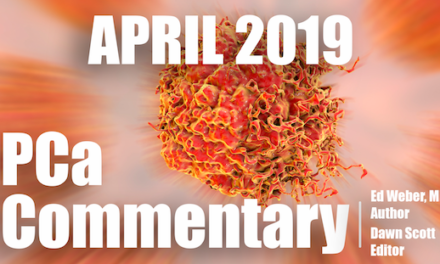
PCa Commentary | Volume 175 – March 2023
Posted by Edward Weber | March 2023
METASTATIC HORMONE SENSITIVE PROSTATE CANCER (mHSPC):
Many Treatment Options
Treatment regimens for mHSPC have been multiply meta-analyzed, likely because of its increasing occurrence. “mHSPC” refers to metastatic cancer imaged at initial diagnosis prior to primary therapy. The higher incidence may be due to the decrease in PSA testing during the decade following USPSTF’s 2012 recommendation against “routine” PSA testing, combined with the current greater use of sensitive PSMA PET scans in men whose initial biopsies showed advanced cancer. The treatments studied in these trials are combination therapies—two triplet regimens—one evaluating darolutamide, docetaxel and ADT (ARASENS) and a second combining abiraterone, docetaxel and ADT (PEACE-1). Trials of doublet therapies compared abiraterone or enzalutamide to ADT alone.
The participants in these studies were predominantly men with advanced cancer with high volumes of metastatic disease, defined as having visceral disease and/or > 4 bone metastases with > 1 metastases outside of the vertebral bodies and pelvis. In both of these trials there were only small numbers of men with low volume disease, which limits applicability of the findings to this category of men.
This Commentary will discuss the clinical applicability of the results derived from these numerous therapeutic permutations.
The triplet combination (ARASENS) — darolutamide, docetaxel (6 cycles) plus ADT verses docetaxel/ADT sets a high bar for overall survival:
At 4 years follow-up overall survival was 62.7% for the triplet vs 50.4% for docetaxel/ADT.
The International ARASENS trial (Smith et al. NEJM. 2022) studied 1306 men with predominantly high-volume mHSPC: 78% with Gleason score > 8; 80% with bone metastases and 18% visceral spread. The risk of death was 32% lower with triplet therapy. Improvement was seen in the triplet study in time to next skeletal event and time to pain progression. Time to the development of castration resistance was prolonged by about 61%.
A second triplet trial (PEACE-1) compared abiraterone(+prednisone)/ADT/docetaxel vs ADT/docetaxel in 1173 men with de novo mHSPC all having a very good performance status. The PEACE-1 trial results confirmed the superiority of the triplet regimen with the risk of death reduced by 25%. The median overall survival in the cohort with high-volume disease was 5.1 vs 3.5 years for the doublet cohort. At a median follow-up of 3.5 years the overall survival rate in the low-volume groups had not been reached, but the progression-free survival favored the triplet group 4.1 v 1.6 years. Hypertension occurred in 22% of men in the triplet vs 13% (doublet), largely due to the known adverse cardiovascular effect with abiraterone.
Of significance, the men in both triplet studies had excellent performance ratings rendering the results less applicable to men with less favorable characteristics or significant morbidities. In both studies serious Grade 3 and 4 adverse effects were seen in ~35%, with 24% showing Grade 3/4 lowering of white blood cells, likely due to the chemotherapy used in both groups. Fatigue occurred in 33% of men, anemia in 26%. The expected adverse effects of depressed testosterone were shared by both groups.
Trial outcomes of the doublet therapies for de novo mHSPC:
Succinctly summarized in “Management of Metastatic Hormone-Sensitive Prostate Cancer: Is Docetaxel Needed?” (Kartolo et al., JCO. 6/2022)
Eight trials have been reported regarding therapy permutations combining ADT, an ASI (androgen signaling inhibitors) such as abiraterone (Zytiga), enzalutamide (Xtandi) or apalutamide (Erleada) or docetaxel (Taxotere). Subgroup analysis of these trials indicate that docetaxel improved survival only in men with high-volume metastatic disease. Trials of these doublet combinations with ADT, abiraterone or docetaxel failed to show significant benefit as opposed to ADT alone in men with low-volume mHSPC. In Kartolo’s opinion, “The benefits of triplet therapy over ADT plus an ASI remains questionable … particularly in men with lower-grade, low-volume mHSPC,” and in these men he would favor the “simpler, less toxic treatment.”
An alternative approach to management of men with “low-volume” mHSPC:
Stereotactic body radiotherapy (SBRT) for men with low-burden metastatic disease (as defined above) based on imaging with a PSMA PET scan allows metastases directed therapy (MDT)–discussed in PCa Commentary Vol. 172 https://www.prostatecancerfree.org/pca-commentary-172
[control+click link to follow or visit https://www.prostatecancerfree.org/pca-commentary]
Radiotherapy targeting the metastatic sites (conventionally less than 3 or 5) and the prostate delays PSA and metastatic progression, and in selected cases may be used without accompanying ADT. The appeal of withholding ADT is not only supported by the avoidance of its toxic adverse effects and its associated immune suppression, but also by its known acceleration of castration resistance by induction of adaptive alterations in prostate cancer cells and the selection of resistance clones.
A variation in the MDT regimen (Phase 2 EXTEND – NCT03599765) was presented at ASTRO 2022 by Tang. This trial “explored the impact of adding metastases directed therapy to intermittent hormone therapy in patients with oligometastatic prostate cancer” (Tang quoted in Urology Times, Feb1, 2023). Radiation therapy was combined with 8 months of intermittent hormone therapy with ADT resumed upon the rise of the PSA. Tang states: “This translated to a 75% reduction in the risk of disease progression or death.”
Radiotherapy to the primary in low-burden mHSPC is supported by major trials. Long-term results at 61 months follow-up for men with low-volume mHSPC from the STAMPEDE Trial (Parker et al., PLOS. June 2022) showed a 46% improvement in overall survival compared to no radiotherapy. A German trial (Merseburger et al. Deutsches Arzteblatt Int. 2022) reported: ”For patients with a light [metastatic] tumor burden, local radiotherapy of the primary tumor improves the probability of survival at 3 yrs by 8% (45.4 versus 49.1 months)…” Morgan et al., (Prostate Cancer and Prostatic Diseases. 2021) reported overall survival in 410 men with mHSPC of 52 vs 40 months in the men in the treated group that remained alive 1 year after radiotherapy.
Morgan concluded: radiation to the prostate may represent a “preferred option” for men with low-volume disease given that it is well tolerated, widely available and delivered over a short period of time.
BOTTOM LINE:
Management options for mHSPC:
The results of the ARASENS and PEACE-1 trials support a triplet drug regimen in fit men with high-volume mHSPC. Alternatively, a doublet therapy may be more applicable for men with low-volume mHSPC, who may also benefit from radiotherapy to the prostate. Metastases directed therapy with or without ADT is another treatment option for men with low-volume mHSPC.
Your comments and requests for information on a specific topic are welcome e-mail ecweber@nwlink.com.
Please also visit https://prostatecancerfree.org/prostate-cancer-news for a selection of past issues of the PCa Commentary covering a variety of topics.
“I want to thank Dawn Scott, Staffperson, Tumor Institute Radiation Oncology Group, and Mike Scully, Librarian, Swedish Medical Center, for their unfailing, timely, and resourceful support of the Commentary project. Without their help this Commentary would not be possible.”
ABOUT THE AUTHOR
Edward Weber, MD, is a retired medical oncologist living in Seattle, Washington. He was born and raised in a suburb of Reading, Pennsylvania. After graduating from Princeton University in 1956 with a BA in History, Dr. Weber attended medical school at the University of Pennsylvania. His internship training took place at the University of Vermont in Burlington.
A tour of service as a Naval Flight Surgeon positioned him on Whidbey Island, Washington, and this introduction to the Pacific Northwest ultimately proved irresistible. Following naval service, he received postgraduate training in internal medicine in Philadelphia at the Pennsylvania Hospital and then pursued a fellowship in hematology and oncology at the University of Washington.
His career in medical oncology was at the Tumor Institute of the Swedish Hospital in Seattle where his practice focused largely on the treatment of patients experiencing lung, breast, colon, and genitourinary cancer and malignant lymphoma.
Toward the end of his career, he developed a particular concentration on the treatment of prostate cancer. Since retirement in 2002, he has authored the PCa Commentary, published by the Prostate Cancer Treatment Research Foundation, an analysis of new developments in the prostate cancer field with essays discussing and evaluating treatment management options in this disease. He is a regular speaker at various prostate cancer support groups around Seattle.




